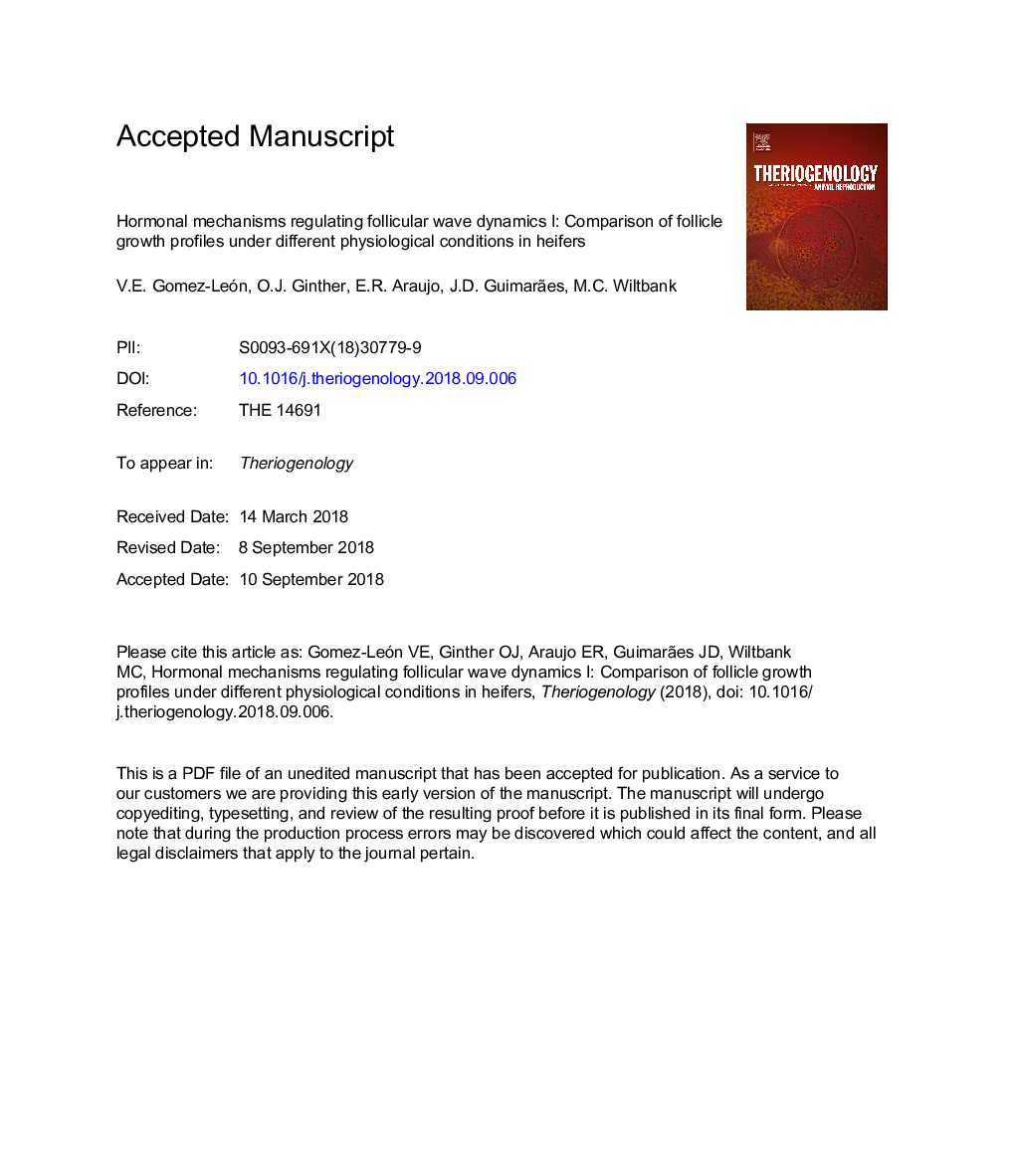| کد مقاله | کد نشریه | سال انتشار | مقاله انگلیسی | نسخه تمام متن |
|---|---|---|---|---|
| 11025966 | 1666464 | 2019 | 34 صفحه PDF | دانلود رایگان |
عنوان انگلیسی مقاله ISI
Hormonal mechanisms regulating follicular wave dynamics I: Comparison of follicle growth profiles under different physiological conditions in heifers
دانلود مقاله + سفارش ترجمه
دانلود مقاله ISI انگلیسی
رایگان برای ایرانیان
کلمات کلیدی
موضوعات مرتبط
علوم زیستی و بیوفناوری
علوم کشاورزی و بیولوژیک
علوم دامی و جانورشناسی
پیش نمایش صفحه اول مقاله

چکیده انگلیسی
Follicle diameter deviation has been identified as the pivotal morphological manifestation of follicle selection, however, many of the hormonal mechanisms leading to this key event and regulating variation between individual follicular waves remain undefined. This study compared circulating FSH, LH, and P4 with the follicular dynamics during three different physiological conditions. We hypothesized that these end-points would: 1) be similar for a spontaneous wave 2 vs one induced by follicular aspiration, 2) but would differ between wave 1 and 2, and 3) between conventional (F2â¯>â¯7.0 mm at deviation) vs undersized (F2â¯<â¯7.0 mm) deviations in either wave. Holstein dairy heifers (Nâ¯=â¯24) were studied daily during an interovulatory interval. All heifers were evaluated during wave 1 and randomized 6 days after ovulation into an induced wave 2 and a spontaneous wave 2. Values were normalized to the day of expected diameter deviation (day 0) and compared for day â2 to 0 and 0 to 2. Hypothesis 1 was supported that an induced wave 2 from ablation of follicles of wave 1 and spontaneous wave 2 have similar follicle dynamics. However, the peak FSH surge was more prominent at emergence of an induced wave 2 (Pâ¯<â¯0.003). Hypothesis 2 was supported that waves 1 and 2 differ in follicle and hormone dynamics. Circulating P4 was lower and LH was greater (Pâ¯<â¯0.01) with no difference in diameter of F1 but with a greater (Pâ¯<â¯0.01) diameter of F2 on day 0 in wave 1 (7.3â¯Â±â¯0.2â¯mm) than in wave 2 (6.6â¯Â±â¯0.2â¯mm). Differences between waves were not found when each follicular wave was categorized into conventional vs undersized deviation and analyzed separately. Hypothesis 3 was supported as there were differences in circulating hormones between conventional and undersized deviations. Growth rate of F2 differed (Pâ¯<â¯0.0005) during days â2 to 0 (conventional, 2.6â¯Â±â¯0.2â¯mm/2d; undersized, 1.4â¯Â±â¯0.3â¯mm/2d). However, circulating FSH and P4 concentration on days â1 and 0 tended to be greater (Pâ¯<â¯0.06) in undersized than conventional deviations. In conclusion, the effect of different hormonal conditions on follicle dynamics was observed for F2 and not for F1. Furthermore, understanding the physiology that produces conventional vs undersized deviations is crucial since these categories explained most differences in follicular dynamics and circulating FSH observed in these different physiological conditions. In addition, future studies of wave 2 may be facilitated by using an induced wave 2 since it was similar to a spontaneous wave 2.
ناشر
Database: Elsevier - ScienceDirect (ساینس دایرکت)
Journal: Theriogenology - Volume 123, 1 January 2019, Pages 194-201
Journal: Theriogenology - Volume 123, 1 January 2019, Pages 194-201
نویسندگان
V.E. Gomez-León, O.J. Ginther, E.R. Araujo, J.D. Guimarães, M.C. Wiltbank,